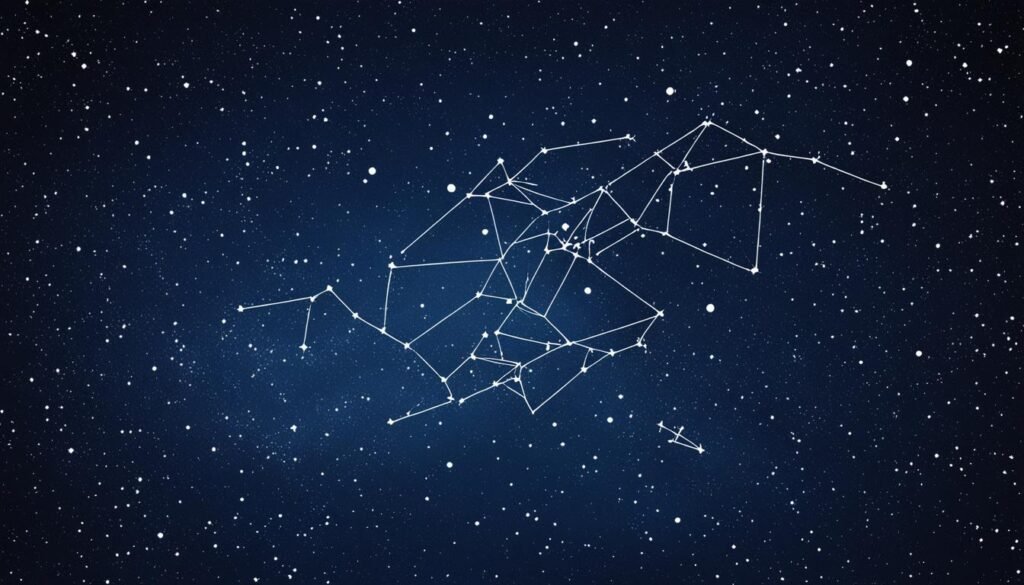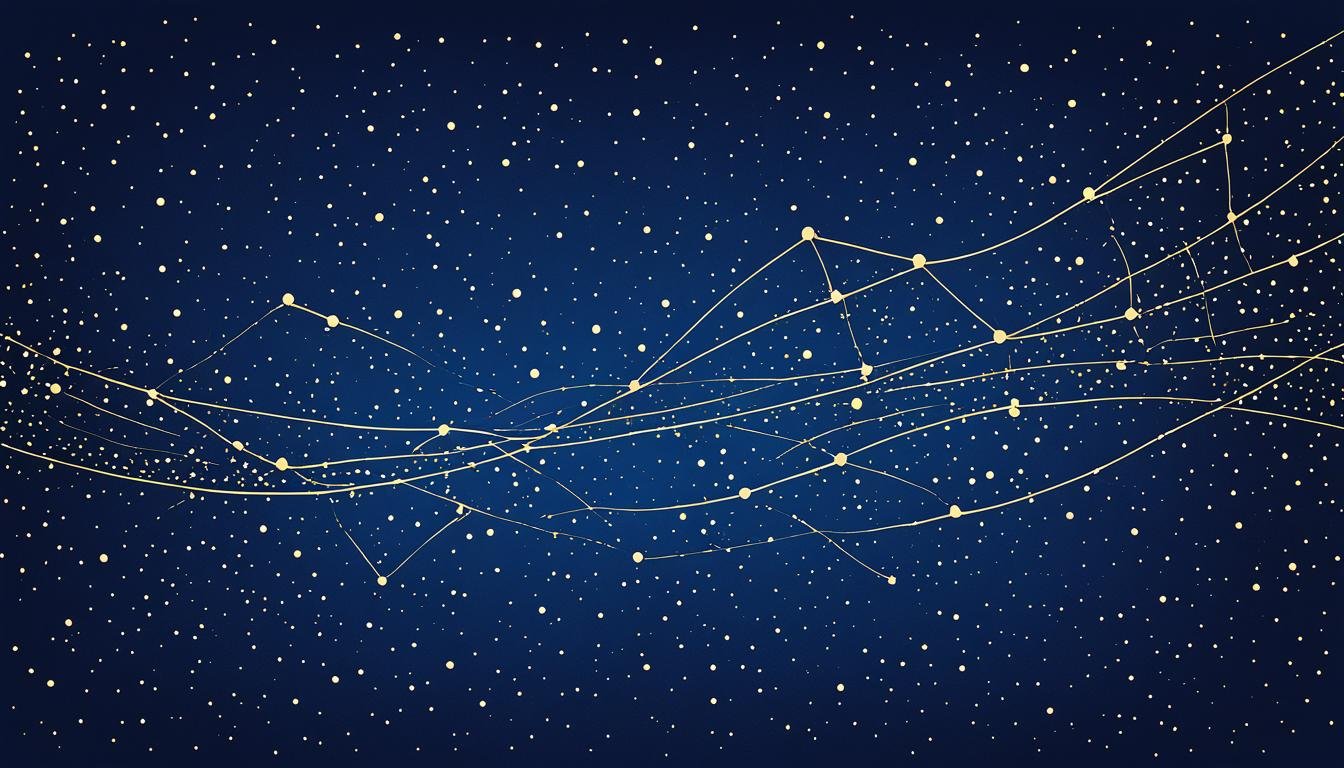| Genitive | |
| Abbreviation | |
| Pronunciation | |
| Main Stars | |
| Brightest Star | |
| Right Ascension | |
| Declination | |
| Sq. Deg. Area | |
| Crosses Meridian | |
| Visible Lat. Range |
When you gaze upon the night sky, the Constellation Corvus beckons as a portal to cosmic tales and celestial grandeur. Known as “the Crow” or “raven” in Latin, this Corvus celestial body is steeped in history and shrouded in the mystery of the stars. As an anchor in our celestial sphere, the Corvus star sign has guarded the southern heavens since being chronicled by Ptolemy in the 2nd century. This documentation marked a pivotal moment in Corvus constellation history, firmly placing it among the stars. With its relatively modest size ranking 70th amongst the constellations, Corvus spans 184 square degrees against the canvas of the sky—a spectacle best witnessed between the latitudes of +60° and -90°.
Amid the interstellar landscape lies the Corvus constellation, surrounded by the prominent constellations of Crater, Hydra, and Virgo. It’s a celestial storybook that unfolds before your eyes, narrating ancient myths through its array of stars. Journey into the cosmos, follow the legacy of Apollo’s sacred bird, and discover the secrets held within Corvus’s wingspan.
Key Takeaways
- The Corvus constellation, a symbol of the raven, reveals a rich narrative rooted in Greek mythology and celestial observation.
- Ptolemy’s records from the 2nd century provide the earliest known documentation, cementing Corvus’s role in constellation history.
- Despite its smaller size, the Corvus constellation commands an area of 184 square degrees in the southern portion of the night sky.
- Positioned among neighboring constellations Crater, Hydra, and Virgo, Corvus is optimally viewed within specific latitudes for a grand stargazing treat.
- The constellation is part of the narrative of global mythologies and stands as a sentinel for observers of celestial movements and astrological significance.
Unveiling Constellation Corvus: An Overview
When gazing up at the night sky, the story of Corvus mythos whispers through the stars of the Corvus constellation. To you, the avid sky-watcher, Corvus represents more than just an arrangement of stars—it is a gateway to ancient tales and astrological belief. This celestial marvel’s name harkens back to the Latin word for “crow,” aligning perfectly with its mythical significance as the sacred bird of Apollo.
Lying snugly in the southern hemisphere’s vast canvas, Corvus occupies 184 square degrees in the third quadrant, marked clearly by the International Astronomical Union with the abbreviation ‘Crv.’ Although Corvus may not be celebrated for its brightness in the cosmos, its stars form a distinctive asterism resembling a sail, often referred to as ‘the Sail’ or ‘Spica’s Spanker.’
As a component of the Hercules family, Corvus might not have an array of resplendent stars, but its brightest gem, Gienah, demands attention with an apparent magnitude that enthusiasts in the field of Corvus astronomy closely follow. Engulfing the lore of the past and the scientific curiosity of the present, your exploration of this constellation is enriched by its historical depths and astronomical significance.
- Latin legacy: Embracing Corvus’ mythological roots and its name originating from ancient Roman culture.
- Hercules family ties: Corvus’ association within a group of constellations sharing common mythological narratives.
- Form and figure: The asterism that characterizes the constellation’s shape, guiding your vision to connect with stories of divine creature.
- Stellar spotlight: Gienah’s brilliance as a beacon within Corvus, guiding both the amateur and the seasoned stargazer.
Whether you’re an amateur stargazer or a seasoned astronomer, your journey through the stars invariably crosses the captivating constellation of Corvus. Its subtle luminosity and ancient Corvus zodiac connections offer a unique serenity and a deeper understanding of the sky’s storied past, as you unravel the layers narrated by the cosmos itself.
Mythological Richness of Corvus Constellation
The constellation of Corvus, steeped in lore, paints a picture of the night sky that reaches far beyond mere points of light. As you gaze upon this celestial tapestry, you’re not just looking at stars; you’re witnessing a saga etched into the cosmos. Let’s delve into the myths that have made Corvus a symbol of intrigue and narrative power throughout the ages.
From Apollo’s Avian to The Raven of the Heavens
In the whispers of ancient Greek lore, the Corvus constellation is said to represent Apollo’s sacred bird. As the tale goes, the crow, once a white-feathered creature, earned Apollo’s wrath and was transformed, its plumage darkening to the black of night. This striking image of a raven set against the stars remains a potent illustration of Corvus star symbolism.
The Transformation of the Crow and Its Stellar Legacy
The metamorphosis of the crow into a celestial figure is more than just a myth; it is an emblem of permanence and transformation within constellations. The Corvus constellation immortalizes the bird’s story, a reminder that even in the face of failure and consequence, there is a place for us among the heavens, our stories etched in starlight for eons to come.
Babylonian to Greek: Corvus Through Different Civilizations
Fascinatingly, the Corvus myth predates the Greeks and can be traced back to Babylonian civilizations, where it too carried significant celestial importance. Different societies across time have looked up to the same arrangement of stars and felt a connection to their own cultural heritage, narratives, and deities, proving that the night sky is a shared human heritage, rich with history and wonder.
Stargazing Guide: Identifying Corvus in the Night Sky
Are you ready to embark on a nocturnal adventure, exploring the stars from the comfort of your backyard? Stargazing is a leisurely pursuit that connects you with the vastness of the universe. Observing the Corvus constellation not only offers an enriching experience but also serves as a gateway to understanding celestial navigation.

Known for its compact and easily recognizable shape, the Corvus constellation is a stellar pattern that beckons the eyes of amateur and seasoned astronomers alike. Before venturing out, ensure you’re equipped with a Corvus constellation map—a key tool in your celestial toolkit.
Mapping the Corvus Star Pattern and its Neighboring Constellations
To begin your journey through the stars, locate the distinct ‘Spica’s Spanker’ asterism within Corvus, characterized by its trapezoid shape. This prominent figure will guide you towards the bright star Spica in the neighboring constellation of Virgo. Alongside Spica, observe how Gamma and Delta Corvi act as celestial signposts, directing your gaze through the cosmos.
Best Times and Locations for Viewing Constellation Corvus
Your stargazing adventure to observe Corvus will be most rewarding when the conditions are optimal. Aim for clear, dark skies away from city lights. The best time to spot this constellation is in the month of May, around 9 p.m. local time, especially when you are between the latitudes of +60° and -90°. During this period, Corvus climbs higher in the sky, offering a splendid view of its stars.
- Prepare your Corvus constellation map for the adventure.
- Locate the ‘Spica’s Spanker’ asterism to orient yourself.
- Use Gamma and Delta Corvi to navigate neighboring constellations.
- Stargaze in May around 9 p.m. for the best view of Corvus.
- Select a location with dark, clear skies, away from urban lighting.
By following these steps and immersing yourself in the tranquil practice of stargazing, you’ll find that observing the Corvus constellation is not just about connecting with the night sky—it’s about connecting with the ancient stories written in the stars.
Astronomical Significance of the Constellation Corvus
When you gaze up at the night sky and find the constellation of Corvus, you’re not only looking at a collection of stars but at a realm flush with fascinating deep sky objects. One of the main features that underscore Corvus’s celestial importance is its host of remarkable galaxies, among which the Antennae Galaxies figure prominently. These spectacular colliding galaxies, catalogued as NGC 4038 and NGC 4039, exemplify the dramatic and dynamic nature of galactic evolutions that decorate the cosmos.

The Corvus deep sky objects are diverse, ranging from distant galaxies to nebulae that hold clues to the birth and death of stars. At the heart of Corvus lies a significant attraction for astronomers and stargazers alike—the Antennae Galaxies. This galactic pair is one of the closest and youngest examples of a pair of colliding galaxies, offering a preview of the cosmic phenomena expected from the eventual interaction between the Milky Way and Andromeda galaxies.
| Feature | Description | Relevance in Astronomy |
|---|---|---|
| Antennae Galaxies (NGC 4038/NGC 4039) | Breathtaking view of two colliding galaxies | Provides insight into the process of galaxy formation and the future of our Milky Way |
| NGC 4027 | Barred spiral galaxy with one asymmetric spiral arm | An example of peculiar galaxy structures potentially resulting from gravitational interactions |
| NGC 4361 | Planetary nebula appearing as a faint elliptical ring | Illustrates the end stages of stellar evolution for sun-like stars |
The Antennae Galaxies are not merely a testament to Corvus’s intrigue but also a compelling aspect of the constellation’s commitment to the enrichment of our understanding of the universe. With each new discovery, the galaxies and nebulas housed within the boundaries of Corvus capture the imagination and evoke the timeless question of what lies beyond our earthly confines.
Exploring the Celestial Bodies of Constellation Corvus
As you venture into the celestial exploration of Corvus, a constellation rich in starry intrigue awaits you. Here within its boundaries, prominent celestial bodies shine, guiding the curious and the passionate who seek to unravel the mysteries above. Whether you’re charting course by the stars or simply indulging in some casual stargazing, Corvus presents a canvas on which the stories of the cosmos are painted, each star a narrator of ancient tales and cosmic phenomena.
The Intriguing Gamma Corvi: Gienah, The Brightest Star
Among the stellar ensemble, Gamma Corvi, known as Gienah, claims the spotlight as the most luminous star within the constellation’s grasp. This celestial beacon not only illuminates the sky with significant magnitude but also anchors the shape of Corvus, guiding you and countless others navigating the expanse of the heavens. When embarking on star exploring in Corvus, Gienah serves as an essential reference point, its bright glow a testament to the awe-inspiring scale of our universe.
Delta Corvi: Algorab, The Crow’s Companion Star
Flanking Gienah in this celestial narrative is Delta Corvi, or Algorab—the crow’s companion star. What makes Algorab particularly captivating is its nature as a double star system, which you can behold through a telescope’s lens. As part of your star guide, this binary star acts as a cosmic crossroads, its dual nature a reminder of the complexities and dualities found within the grand tapestry of space.
Other Stellar Wonders: Noteworthy Stars within Corvus
Yet, the constellation’s charm does not end with Gienah and Algorab. Eta Corvi punctuates the constellation’s allure with the mystery of its surrounding debris disk, possibly a whisper of its youthful past. Additionally, binary systems like VV Corvi offer a glimpse into the dynamic partnerships that exist beyond our terrestrial sphere. There’s a wealth to discover in your celestial journey through Corvus—each discovery contributing to a richer understanding and appreciation for the vast sky above.
FAQ
What is the significance of the Corvus constellation in astronomy?
The Corvus constellation, while not the largest, has considerable astronomical significance due to its distinct shape and the bright stars it houses. Along with its star pattern that people have recognized across various cultures and historical contexts, Corvus contains intriguing celestial objects like the Antennae Galaxies that offer insights into galactic interactions.
What mythological stories are associated with Constellation Corvus?
Constellation Corvus is steeped in mythology, most notably connected with the story of Apollo’s sacred bird. According to Greek mythology, Corvus was turned black and placed in the sky as a raven by Apollo as punishment. This star sign also plays a role in the mythologies of other ancient cultures, including the Babylonian and Chinese civilizations, each attributing its own narratives and significance to the constellation.
Where does the name ‘Corvus’ originate, and what does it mean?
The name ‘Corvus’ is of Latin origin and translates to ‘crow’ or ‘raven.’ This reflects the constellation’s representation of the sacred bird associated with Apollo in Greek myth. The constellation’s name has also influenced the themes of Corvus star symbolism throughout history.
When and how can I best observe the Corvus constellation?
To observe the Corvus constellation, you can look to the skies between the latitudes of +60° and -90°, with May at around 9 p.m. being the optimal viewing time. Its four brightest stars create the recognizable ‘Spica’s Spanker’ asterism, which can guide stargazers to the bright star Spica in the constellation Virgo.
Which stars are considered the main celestial bodies in the Corvus constellation?
The main celestial bodies in the Corvus constellation include Gamma Corvi (also known as Gienah), the brightest star, and Delta Corvi (Algorab), notable for its double star system. Other significant stars include Eta Corvi, which is observed for its surrounding debris disks, and various double and binary stars, such as VV Corvi.
How does Corvus astrology interpret this constellation?
While Corvus is not part of the traditional zodiac, it holds astrological interest due to its prominent stars and historical significance. In Corvus astrology, the constellation’s positioning and the qualities attributed to its main stars – such as Gienah’s brightness – may be considered by some astrologers in thematic interpretations.
Are there any significant deep sky objects located in Corvus constellation?
Yes, the Corvus constellation is home to several deep sky objects of interest. The Antennae Galaxies, a pair of interacting galaxies, are one of the most significant celestial sights within this constellation. Additionally, it encompasses the NGC 4038 group of galaxies, which adds to Corvus’s astronomical significance.
What is the historical background of the Corvus constellation?
The historical background of the Corvus constellation dates back to ancient times. It was cataloged by the 2nd-century Greek astronomer Ptolemy and has always been associated with various legends and myths throughout cultures. Its notation as a celestial marker spans across millennia, highlighting Corvus’s enduring presence in humanity’s gaze towards the heavens.
Does the Corvus constellation have any significance in different cultures?
Indeed, the Corvus constellation holds significance in many different cultures. In Greek culture, it represents Apollo’s raven, whereas in Babylonian astronomy, it was seen as a raven on a serpent’s tail. Diverse cultures integrated Corvus into their mythological and astronomical studies, confirming its broad influence.






